How to Get Rid OfRaccoons
44 min read Updated for October, 2019
They look like cute and cuddly creatures, but raccoons can be more than a nuisance—they can be dangerous to humans. As the population grows and more land gets developed, raccoons can end up with fewer and fewer natural places to build dens. Thus they can end up choosing your attic, chimney or some other part of your property to take up residence and that can leave you with a big problem that needs solving, quickly.
44 min read Updated for October, 2019

Raccoon Sounds
Extremely vocal animals, raccoons communicate using more than 200 different sounds, which include chittering, purring, growling, snarling, hissing, and whimpering. Fighting raccoons sound like that of fighting cats, and they can scream with an owl-like screech. Baby raccoon will even mewl, cry, and whine.
Raccoon Tracks
Raccoons have five toes on both front and hind feet, with long, nimble fingers for grasping and getting into things. Their hind feet (and legs) are much larger than the front and their prints are often compared to that of human baby hand- and footprints.
Raccoon Poop
Raccoon poop is very similar to dog droppings but with the telltale sign of undigested food, the biggest tell being the addition of berries. Their poop is usually two to three inches long, three-quarters of an inch in diameter, with rounded or broken off tips, and textured sides.
Identify
Common Species
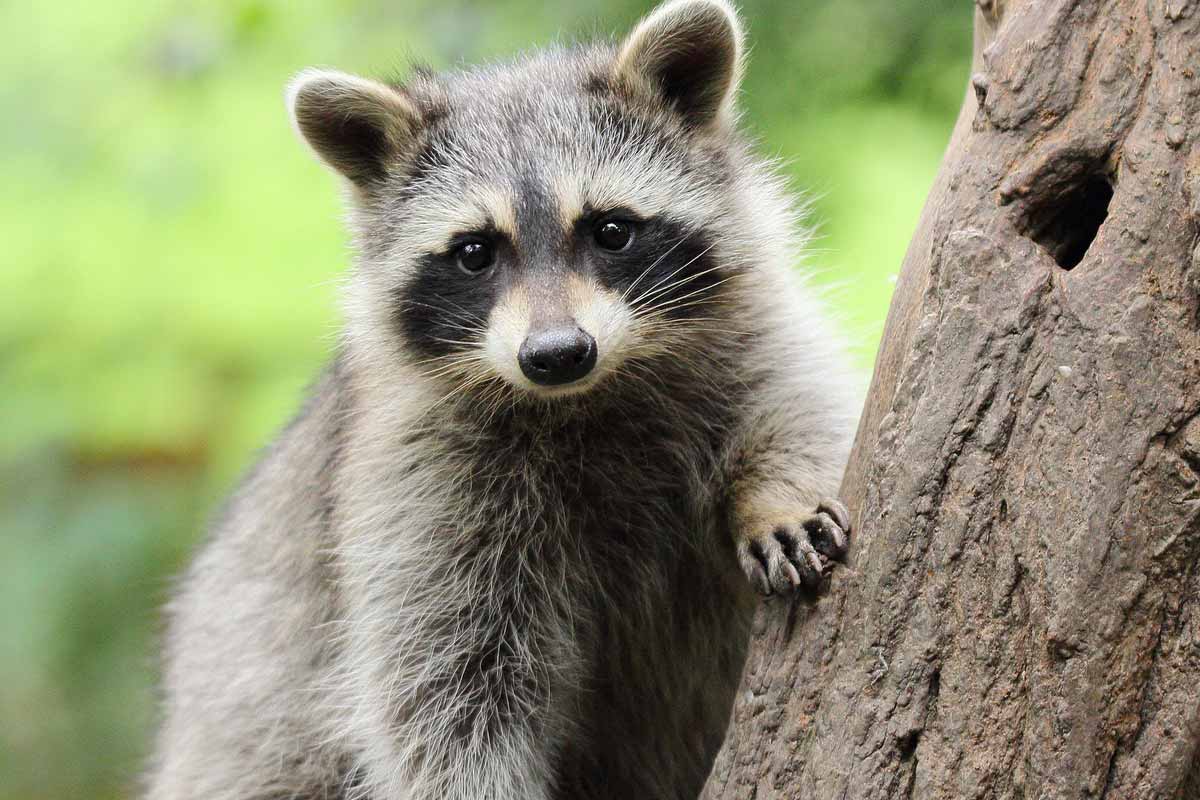
Raccoon
There are several different types of raccoons worldwide, but the only one you will encounter in the United States is the North American Raccoon.
Appearance
- Two to three feet long, nine to 10 inches tall, weigh between 10 and 30 pounds
- Grayish brown fur, black fur mask covering eyes, five to eight alternating light to dark rings on tail
- Five toes on front paws, hind legs longer than front legs
Behavior
- Live in riverbanks, hollow trees or logs or abandoned burrows
- Nocturnal animals who eat at night feeding mostly on fruits, plants, nuts, berries, insects, rodents, frogs, eggs, and crayfish
- Mating season between January and June, mother raccoons separate and raise young alone
Common Locations
Raccoons are a very adaptable animal and can be found all across the United States, although you won’t typically find them in Arizona, Nevada, Utah and some parts of the Rocky Mountains. They originally lived in tropical locations and spent their time foraging along riverbanks. But their adaptability allowed them to expand their territories and their diets.
Raccoons prefer to call hollow logs or trees, riverbanks and abandoned beaver lodges home. While they will eat just about anything, they are particularly fond of feeding on creatures that live in the water. That’s why raccoon dens can often be found in wooded areas by ponds, lakes, marshes or streams. They also set up dens in barns, sheds, attics, chimneys, crawl spaces, and abandoned vehicles. It’s not unusual to find them deep in a forest or in the middle of a well-developed city. Raccoons survive well in urban areas mostly because of an abundance of human food and a general absence of animals that prey on them.
Raccoons are nocturnal animals, so they generally only venture out at night for food. Raccoons usually stay within a one-mile radius, but depending on the food supply, they can travel several miles to search for something to eat.
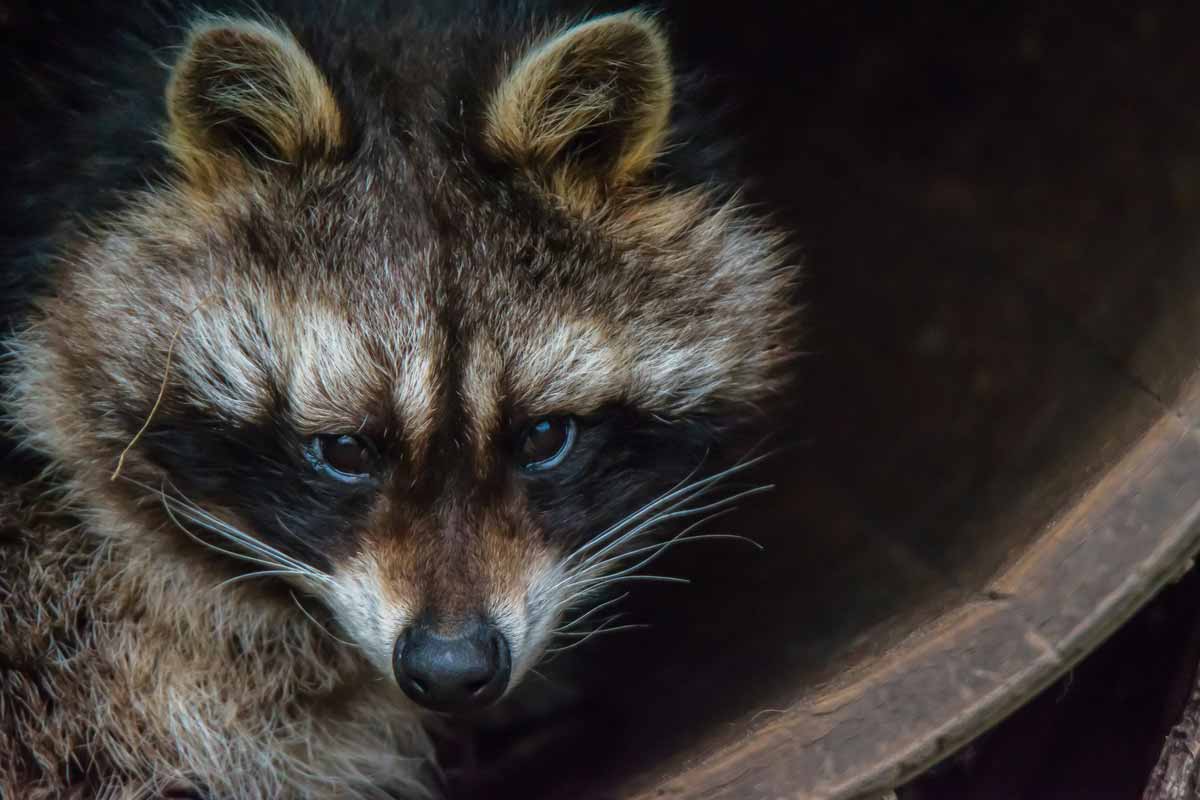
Treating Your Property For Raccoons
Raccoon Problem?
Raccoons become dormant in the coldest of winter months, but do not truly hibernate.
Why They’re There
There are only three reasons you’ll find a raccoon living in or around your property—proximity to a food supply, a mother needs a home to nurse and wean her babies, known as kits, or a raccoon needs a home for the winter.
Raccoons spend most of their day sleeping. They come out of their dens around dusk and spend their night rummaging around looking for food. The furry tailed animals will eat just about anything, but love to feast on animals who live in water like clams, crayfish, frogs, fish, and snails. They will also chow down on insects, slugs, dead animals, birds and their eggs, and fruits, vegetables, nuts, and seeds. Raccoons will help themselves to any pet food outside, and they like rummaging through garbage and garbage cans. And campers should know that raccoons can and will raid campsites looking for food, as well.
If you raise crops, you may find raccoons eating up your sweet corn, tomatoes or watermelon during the latter part of the growing season. Because of their human-like paws, they can pull corn husks back and eat the corn off the ear. They also break corn stalks as they climb up and down them or pull at them to get to the corn. They will dig into a watermelon and hollow out the contents with their paws. Raccoons can do significant damage to farm crops.
For a long time, raccoons were thought to be loners, but wildlife experts say they do congregate with their own gender. Mating season occurs between January and June, and a mother raccoon will separate herself at that time and raise her kits alone. Mother raccoons typically give birth during the spring and will look for a warm, safe, quiet and dark place to give birth and raise the babies. The kits stay in the den until they are between eight and ten weeks old. Attics, sheds, and chimneys have served as favorites for a mother raccoon looking for a home for her newborns.
Raccoons become dormant in the coldest of winter months, but do not truly hibernate. They rely on their body fat storage (which is even in their tails) for nutrition. They will emerge on warmer days during those months to look for food and water.
Raccoon Sounds
Extremely vocal animals, raccoons communicate using more than 200 different sounds, which include chittering, purring, growling, snarling, hissing, and whimpering. Fighting raccoons sound like that of fighting cats, and they can scream with an owl-like screech. Baby raccoon will even mewl, cry, and whine.
Raccoon Tracks
Raccoons have five toes on both front and hind feet, with long, nimble fingers for grasping and getting into things. Their hind feet (and legs) are much larger than the front and their prints are often compared to that of human baby hand- and footprints.
Raccoon Poop
Raccoon poop is very similar to dog droppings but with the telltale sign of undigested food, the biggest tell being the addition of berries. Their poop is usually two to three inches long, three-quarters of an inch in diameter, with rounded or broken off tips, and textured sides.
Inspect
Chipmunks are reasonably easy to identify due to their distinctive stripes, although they’re sometimes confused with their close relative the squirrel. However, knowing the typical size, behavioral patterns, and markings of the chipmunk can help you distinguish it from other small rodents.
How Do I Know If Raccoons Are In My Attic Or Chimney?
You will know if a raccoon has taken up residence in some part of your attic, crawl space or chimney. They are not quiet house guests. They do everything loudly—walk, move around, eat—it’s all done with a lot of noise. Heavy footsteps are often the first sign raccoons are around. Because they are nocturnal, you are most likely to hear them after dusk.
Raccoons are messy. If you find old food and bones all over the attic, then chances are you have raccoons. They also use twigs, leaves or insulation to build their nests, so look for a significant amount of those things if you think a raccoon has taken up residence. They will typically pick out one area for their bathroom, so if you find a place in the attic that has a lot of feces, that’s a good sign raccoons are living there.
Raccoons are big animals, so they need large openings to get inside. If they can’t find one, they will create one if they want inside bad enough. If you find vents, shingles, roofing tiles or drywall that’s been ripped up or torn, you might have a raccoon problem.
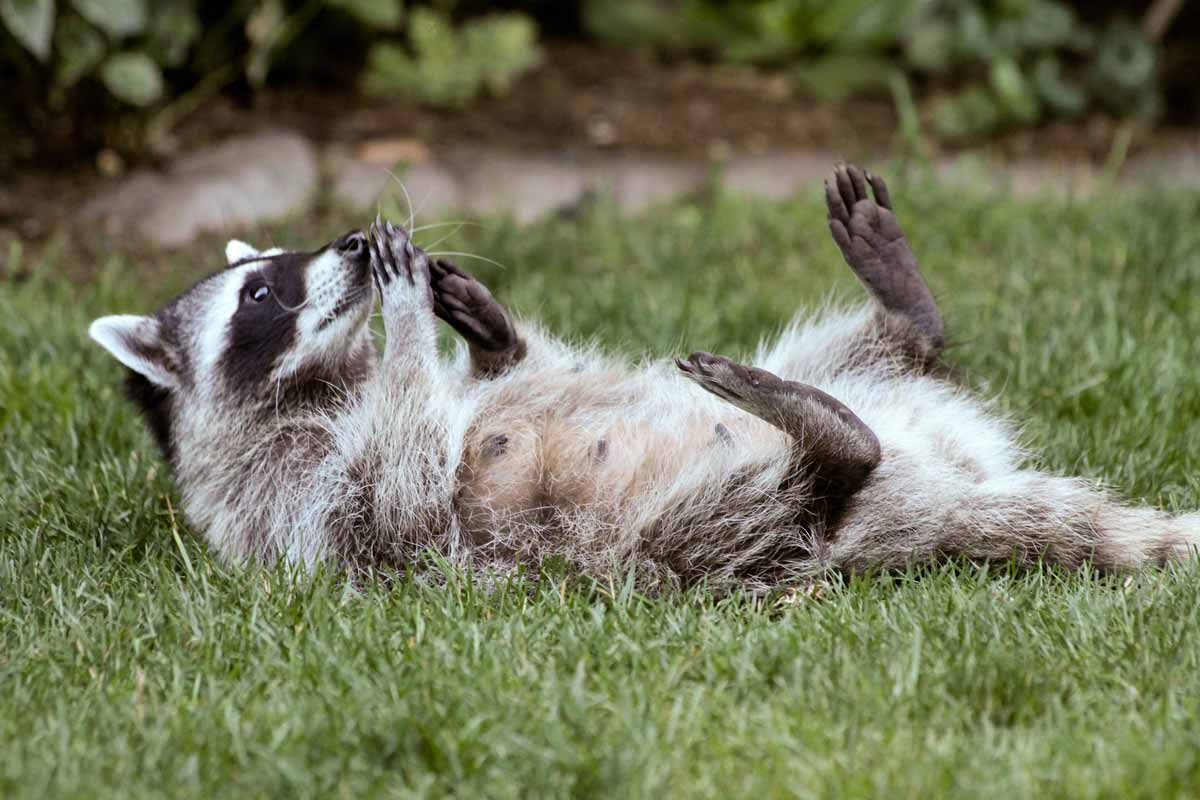
Should I Relocate Raccoons?
Trying to trap and relocate a raccoon yourself is not recommended, and in some states, it isn’t legal. So, you will want to check your state laws first. The best option is to try and encourage them to leave on their own. Before attempting to trap and relocate a raccoon, you should assume it is a mother and her kits living there. If you only trap the adult raccoon, the babies, who haven’t left the den, will end up starving and dying in your attic or chimney.
Even if you trap them together, putting them in a new environment can have dire consequences, and they may not survive. Wildlife experts say wild animals don’t adjust well to new environments. They can become disoriented, and it may take some time to find food, shelter, and protection from predators. So even if you are trapping only adult raccoons, they may not end up surviving in their new surroundings.
Treating Your Property For Raccoons
Raccoon Problem?
Raccoons do most of their roaming around at night.
Raccoons Are Nocturnal Animals. What Does It Mean If I See One During The Day?
Raccoons do most of their roaming around at night. Seeing a raccoon during the day may be unusual, but it isn’t unheard of. Raccoons could be searching for food longer because there are babies to feed or they may be searching for a new home. Raccoons can be a bit like a drifter; they don’t stay in places for too long. Just because you see a raccoon in the daylight isn’t cause for alarm.
If the raccoon you see during the day is exhibiting unusual behavior, then it may be rabid. If the animal is staggering around, oblivious to movement around it, wandering with no purpose, has discharge from its eyes or mouth, has wet or matted hair on its face, making repeated loud noises or trying to hurt itself, then you will definitely want to call your local animal control department to come to take care of it. It is likely rabid and a danger to you and any other animal in the area.
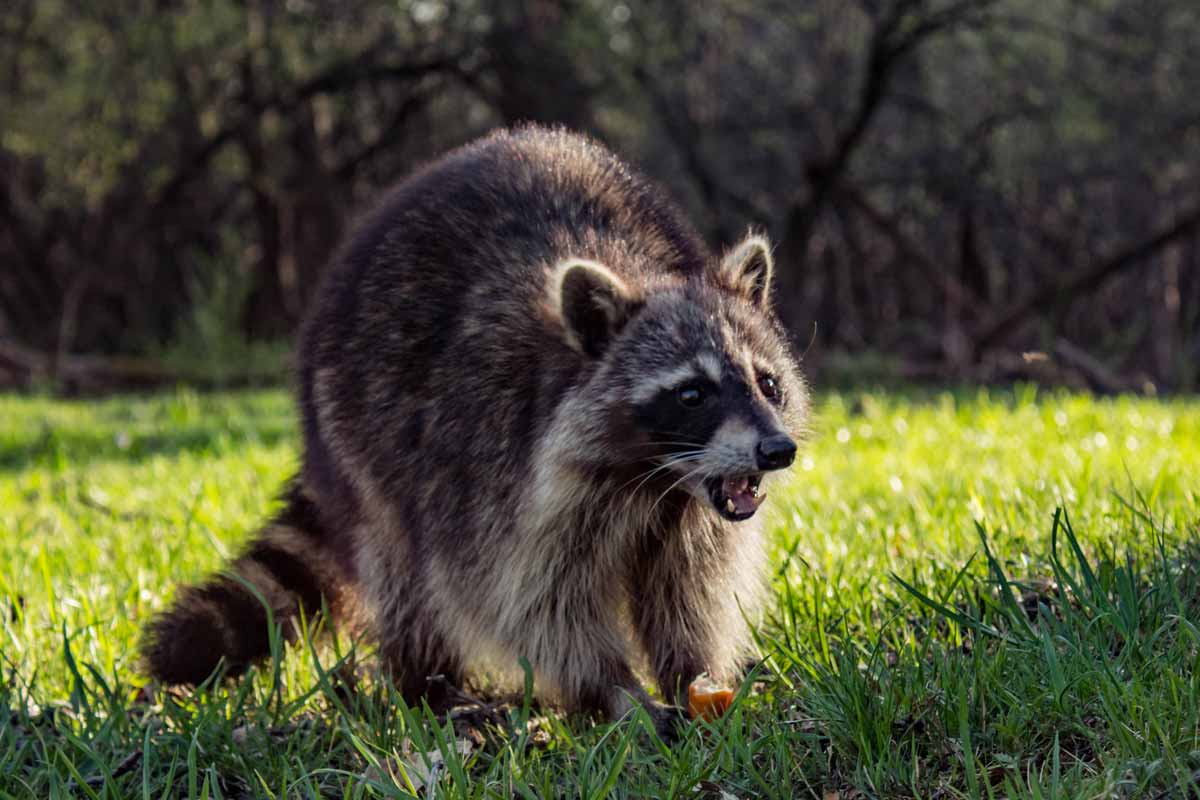
Gather The Tools You’ll Need
Ladder
A ladder will help you see in high places in and around your house
Flashlight
A flashlight will help you spot small or large, dark openings in and around your house, shed or property
Gloves
Wear thick, protective gloves that you can throw away
Face Mask
Wear a mask to filter out airborne animal waste
Protective Clothing
Cover yourself thoroughly and throw the clothes away to protect against contracting and spreading disease
Baby raccoons can’t leave the den until they are mobile, which doesn’t occur until they are at least eight weeks old.
How To Steps For Diy Removal
If you want to tackle your raccoon problem yourself, there are ways to do that. The first step is to determine if you have a mother and her kits calling your house home. If so, your first step may be to wait it out. Baby raccoons can’t leave the den until they are mobile, which doesn’t occur until they are at least eight weeks old.
Mother raccoons don’t stay in their nursery den too long, anyway. Once the babies can leave the den and forage with her, she will likely move their den to a new place. In the meantime, there are some easy and humane ways to encourage a mother or any raccoon to leave.
Get a battery-powered radio, tune it to an all-talk station and play it at a reasonably loud volume, especially during the day. You can also get a battery-powered light and position it to shine towards the den during the day. The light will disturb the mother while she’s trying to rest.
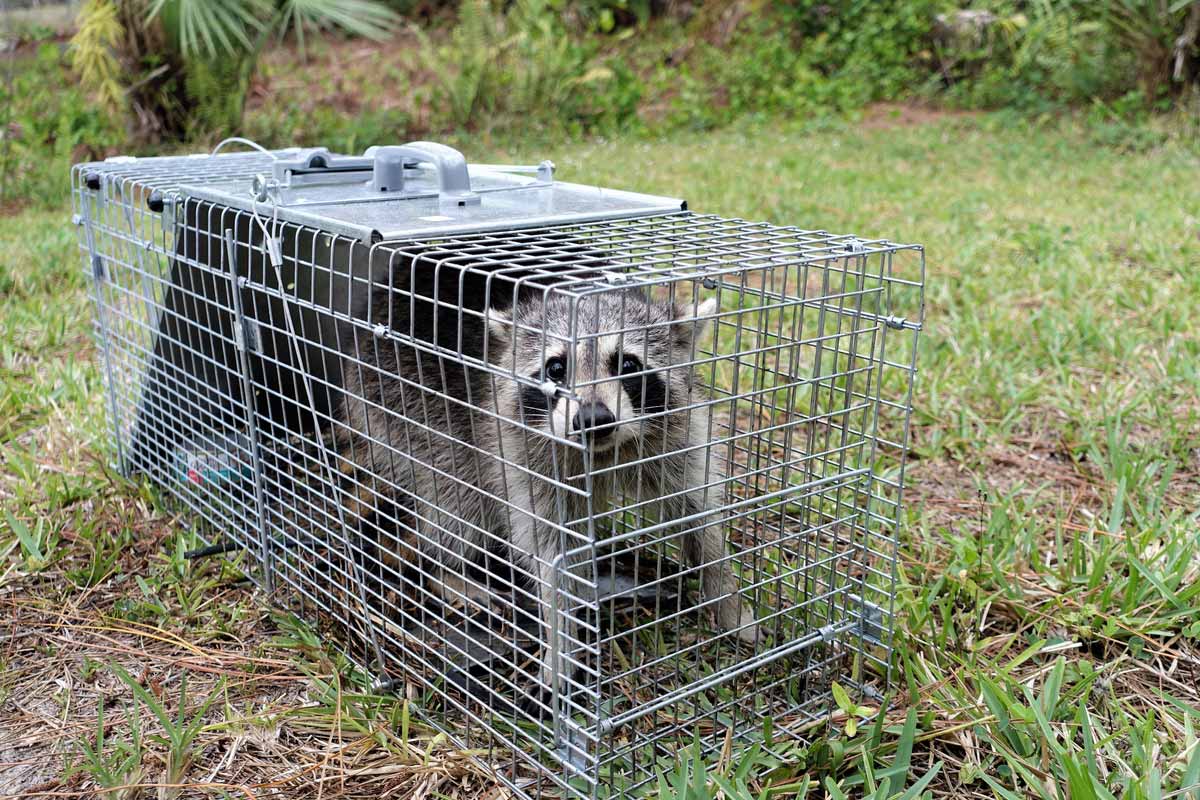
Don’t have direct contact with the raccoons but make several trips over the course of a couple of days to the area where the den is. The activity will make a raccoon, especially a mother with babies, feel insecure and encourage her to move. The animal may not move right away. It may take several days because it will need to find a new den.
Raccoons don’t like the smell of mothballs. You can throw some in the attic, crawl space or even chimney and it will cause the animal to vacate the premises. Use caution if there are baby raccoons involved, they may not be big enough to move away from the scent and end up dying.
Raccoons aren’t fans of cayenne pepper. Mix a small can of cayenne pepper and one bottle of hot sauce with a gallon of water and spray it all over your plants, bushes, and shrubs. You will need to respray after every rainfall.
The furry animal doesn’t like the smell of ammonia either. Soak several rags with ammonia and place it around the entrance to the den. You can also spray ammonia in trash cans. The smell will repel raccoons, but you have to replace the rags and frequently spray to keep them from coming back. There are several different types of granular or spray repellents you can buy and try, as well.
You may want to test to see if the raccoons have indeed left. You can place a piece of plastic or wad up newspaper around the entrance and exit hole. If it isn’t moved or torn up in three days, then you know the raccoon is gone.
Once you are able to get the raccoon to move out, you will want to carefully and thoroughly clean the area they’ve been living in. It’s best to use an enzymatic cleaner. It will clear the area of bacteria and any disease-causing organism the raccoons may have been carrying. It will also get rid of any odors they leave behind. You should throw away anything you use for cleaning or wear while doing it to keep you or a family member from contracting a disease.
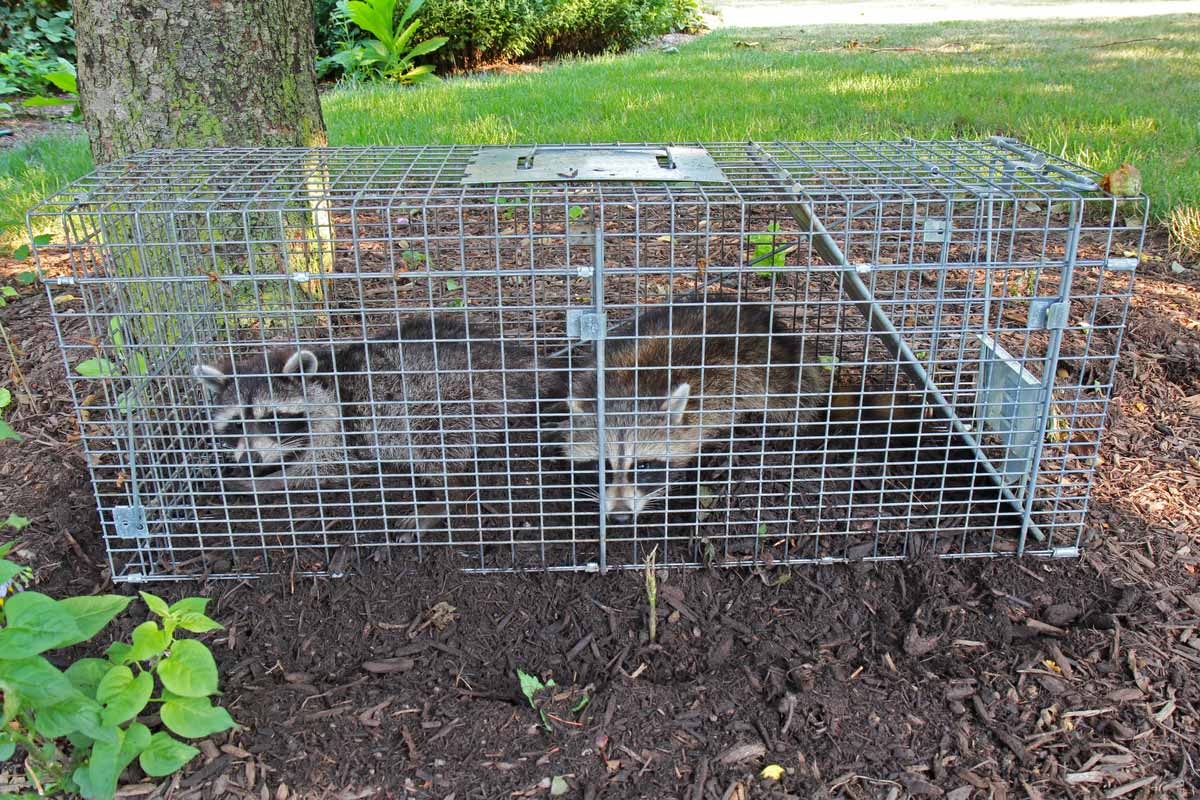
Raccoons are one of the most common carriers of rabies in the United States.
Risks Of Disease
Saying a raccoon is a disease carrier is an understatement, and they can not only be a danger to you but to your pets, as well. The best advice is to stay away from them. But if you’ve touched or fed a raccoon, been bitten or scratched by one or been exposed to a raccoon’s urine or feces, you should go to the doctor as soon as possible.
Raccoons Carry Rabies.
Raccoons are one of the most common carriers of rabies in the United States. It can spread to you or your pet from a raccoon’s saliva or from being bitten or scratched by one.
According to the Centers for Disease Control and Prevention (CDC), the first symptoms of rabies are similar to the flu. For several days you can feel weakness or discomfort, run a fever or suffer from a headache. As the disease progresses, an infected person will experience cerebral dysfunction, anxiety, confusion, agitation, delirium, abnormal behavior, hallucinations, and insomnia.
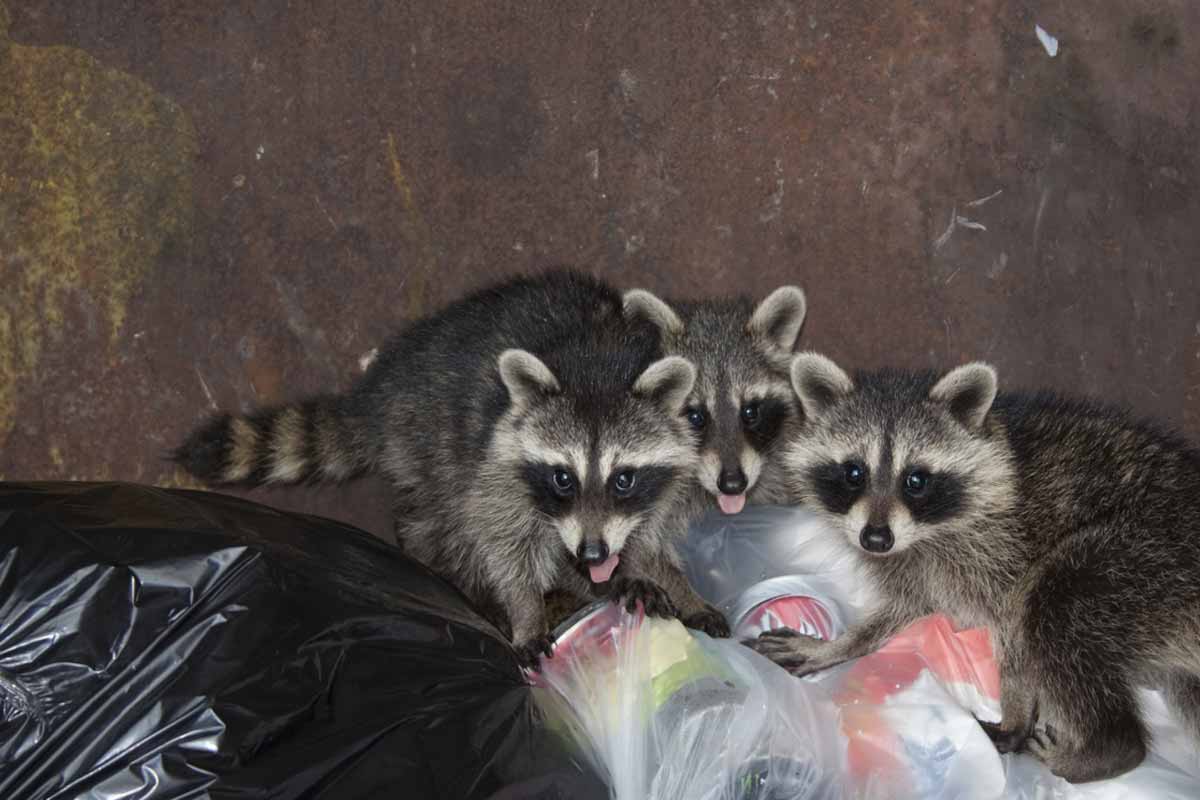
Rabies has to be caught and treated early. The CDC says once clinical signs of rabies appear, the disease is almost always deadly.
In your pets, American Humane says to watch first for behavioral changes. Your dog or cat may be anxious, aggressive or overly friendly. As rabies progresses, your pet will develop hypersensitivity to light and sound, may have seizures and become extremely vicious.
Raccoons Carry Roundworm.
Baylisascaris procyonis or roundworm is a parasite found in the intestines of raccoons. The roundworm sheds large numbers of eggs in the feces of raccoons. Infection occurs if a person ingests the infectious eggs, which happens most often in children or others who are more likely to put dirt or animal waste in their mouth by mistake.
It can take between one and four weeks for symptoms to present themselves, but you should go to the doctor immediately if you think you’ve been exposed. Baylisascaris procyonis is not contagious, but it can affect the brain, spinal cord, eyes or other organs. No drug has been found to be completely effective in treating this type of roundworm. The CDC says symptoms include:
- Nausea
- Tiredness
- Liver enlargement
- Loss of coordination
- Lack of attention to people and surroundings
- Loss of muscle control
- Blindness
- Coma
It can take between two and four weeks for the eggs in raccoon feces to become infectious. You should dispose of it immediately and properly to avoid getting sick. Carefully remove, burn and bury it or send it to a landfill and avoid getting it on your hands and clothes. Use boiling water or a propane flame-gun to treat decks, patios or other outdoor surfaces it may have come in contact with.
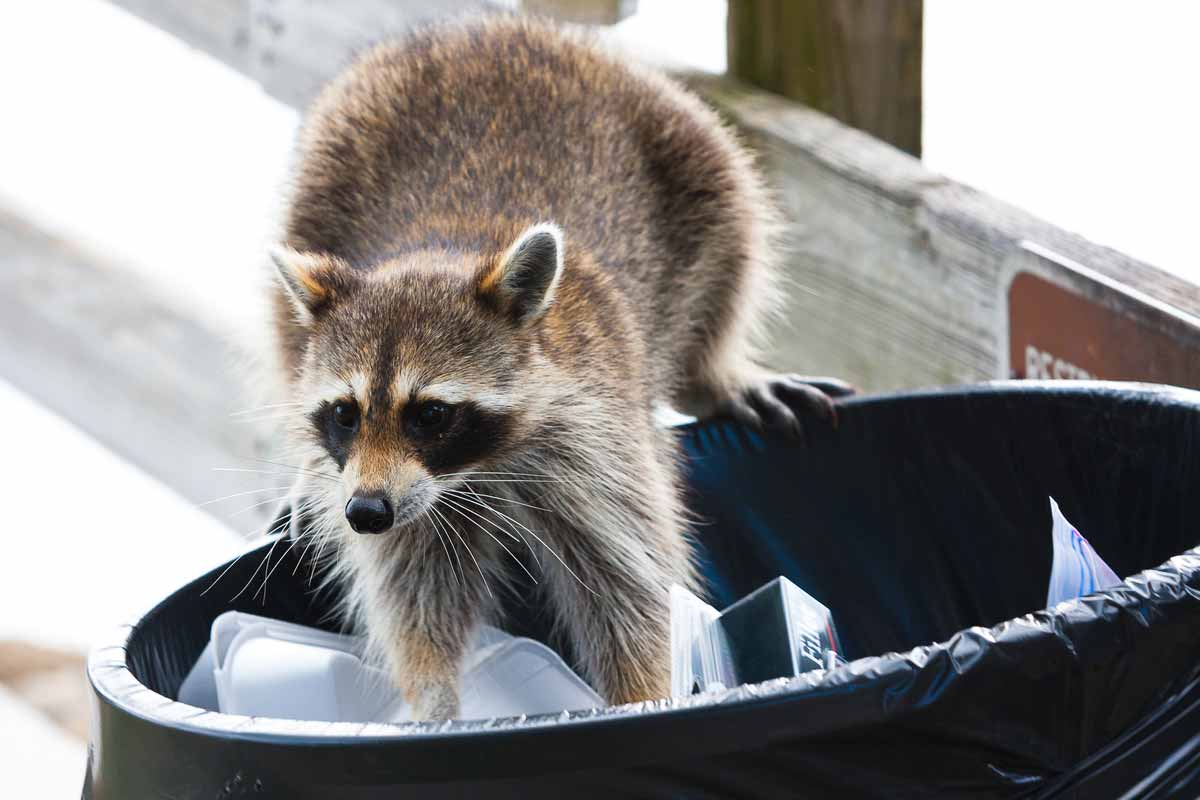
Dogs can contract this type of roundworm and spread it through their feces. Here are the symptoms to look for in your dogs:
- Unsteady walking
- Loss of coordination or muscle control
- Difficulty eating or swallowing
- Lethargy
- Circling
- Seizures
- Confusion
Raccoons Carry Giardiasis.
Giardiasis is sometimes called a “swimming pool” disease because it is often transmitted through water from a pool or other body of water you might swim in. Raccoons carry the organism in their feces and contaminate water, soil or other surfaces. People become infected when they swallow the parasite.
There are plenty of prescription drugs that will treat Giardiasis. Symptoms begin between one and three weeks of becoming infected and include:
- Diarrhea
- Gas or flatulence
- Greasy stool that floats
- Stomach or abdominal cramps
- Upset stomach
- Nausea
- Dehydration
Dogs and cats are commonly infected with Giardiasis. The CDC says to look for:
- Diarrhea
- Gas
- Abdominal discomfort
- Nausea
- Vomiting
Raccoons Carry Leptospirosis.
Leptospirosis is a bacterial infection that raccoons shed in their urine and other secretions. It can be contracted orally or through open wounds. It can take between two days and four weeks for the onset of symptoms, which include:
- High fever
- Headache
- Chills
- Muscle aches
- Vomiting
- Jaundice
- Red eyes
- Abdominal pain
- Diarrhea
- Rash
Someone with Leptospirosis can recover and then get sick again. The second time around is much more severe and can result in kidney or liver failure or meningitis. It can take several weeks to several months to fully recover.
Your pets can also contract Leptospirosis. Here are the common symptoms that have been reported to the CDC:
- Fever
- Vomiting
- Abdominal pain
- Diarrhea
- Refusal to eat
- Severe weakness and depression
- Stiffness
- Severe muscle pain
Raccoon Sounds
Extremely vocal animals, raccoons communicate using more than 200 different sounds, which include chittering, purring, growling, snarling, hissing, and whimpering. Fighting raccoons sound like that of fighting cats, and they can scream with an owl-like screech. Baby raccoon will even mewl, cry, and whine.
Raccoon Tracks
Raccoons have five toes on both front and hind feet, with long, nimble fingers for grasping and getting into things. Their hind feet (and legs) are much larger than the front and their prints are often compared to that of human baby hand- and footprints.
Raccoon Poop
Raccoon poop is very similar to dog droppings but with the telltale sign of undigested food, the biggest tell being the addition of berries. Their poop is usually two to three inches long, three-quarters of an inch in diameter, with rounded or broken off tips, and textured sides.
Prevent
Prevention
It’s difficult to protect your property completely from wildlife, but there are steps you can take to make it less likely for raccoons to move in.
Raccoons are always foraging for food, and garbage cans are like gold mines for them. Because they can stand on their back legs and use their front paws like hands, they can easily get inside trash cans. Make sure your cans are tightly shut and stored in areas that aren’t easily accessible.
Don’t feed them. Raccoons, especially baby ones, seem like cute creatures but providing food for them is a bad idea. Wildlife experts say raccoons that are fed by people lose their fear of humans and can become aggressive if they aren’t fed as expected. Having them around routinely can also create a health hazard for you, your neighbors and your pets.
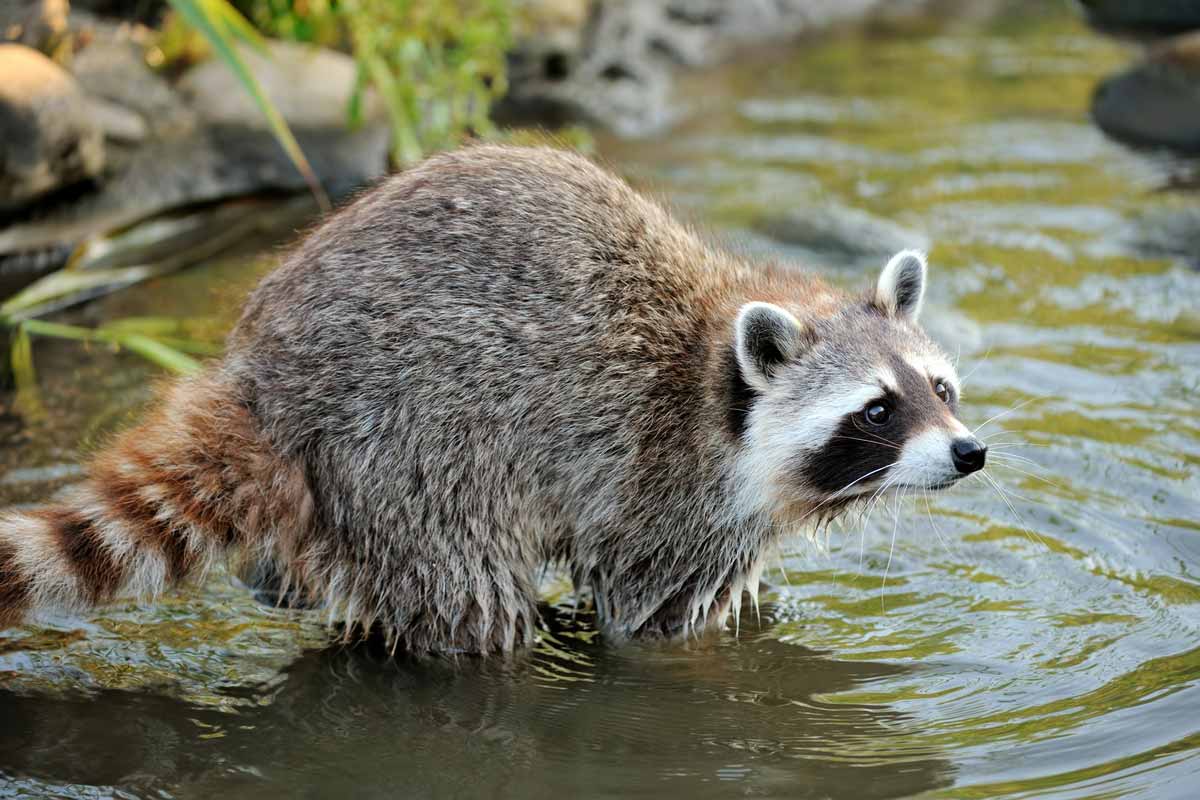
Any food you eat outside needs to be cleaned up. Don’t leave food that gets dropped on the ground and be sure to clean up your grill that can be an invitation for raccoons to visit your backyard.
If you have pets, keep them inside if possible. Raccoons are known to attack dogs and cats, which can lead to disease or injury for your pet. Try and feed your pets inside, but if that isn’t an option, feed them during the day. Be sure and pick up food, water bowls, leftovers and spilled food before it gets dark. Be sure and keep your pet door locked at night also.
Fences are another way to keep raccoons out, so you may want to consider putting one around your property. Raccoons are excellent climbers, so you may want to add an electric fence wire around it to keep them away.
These animals will use various ways to get inside your sheds, crawl spaces or attics. A little opening can become an entry point for them. Do regular checks and maintenance on structures you have. Repair storm damages quickly and fix any place that might be an open invitation for raccoons. Use sturdy materials—like common home construction materials, steel mesh or plates, bolts, nails, and screws—to repair the holes.
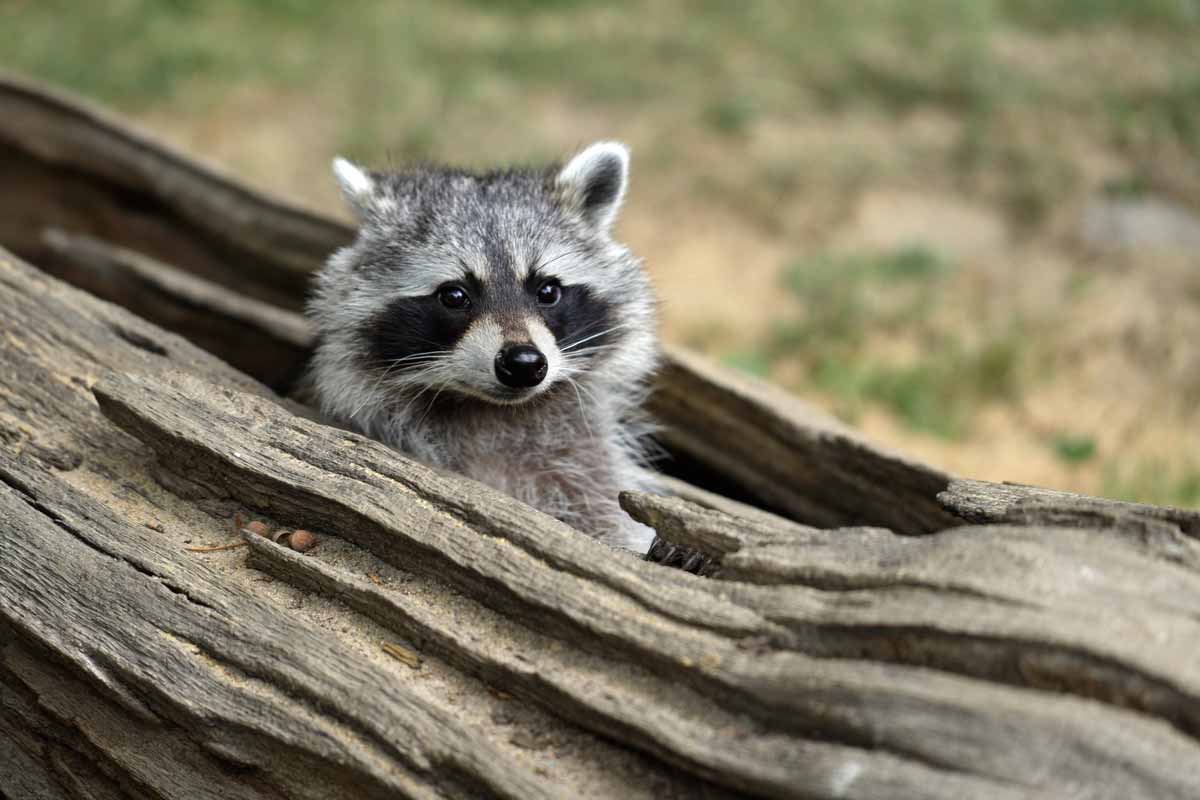
Keep raccoons off your roof and away from your attic by keeping tree limbs trimmed back. They may be able to climb the tree, but they won’t be able to jump off onto your roof. You can also install sheets of metal flashing around corners of any structure on your property to keep them away. Ivy and other vegetation that can grow on walls and posts are pretty, but it can become a ladder for raccoons. So, avoid allowing it to grow on your house, garage or shed.
Motion-sensor lights and sprinkler systems can be deterrents to a point. After a few days, if there is no other threat, the raccoon will continue to return to look for food.
Chimneys create a nice safe haven for a mother and her babies. So, it’s best to ensure they can’t get inside to begin with by installing a professionally made chimney cap.
If you raise poultry, keep them and their eggs safe. Make sure your poultry houses have well-fitting doors and secure locks. Raccoons paws work like human hands, so they can open some latches and knobs.
Treating Your Property For Raccoons
Raccoon Problem?
Raccoon Sounds
Extremely vocal animals, raccoons communicate using more than 200 different sounds, which include chittering, purring, growling, snarling, hissing, and whimpering. Fighting raccoons sound like that of fighting cats, and they can scream with an owl-like screech. Baby raccoon will even mewl, cry, and whine.
Raccoon Tracks
Raccoons have five toes on both front and hind feet, with long, nimble fingers for grasping and getting into things. Their hind feet (and legs) are much larger than the front and their prints are often compared to that of human baby hand- and footprints.
Raccoon Poop
Raccoon poop is very similar to dog droppings but with the telltale sign of undigested food, the biggest tell being the addition of berries. Their poop is usually two to three inches long, three-quarters of an inch in diameter, with rounded or broken off tips, and textured sides.
When to Call a Professional
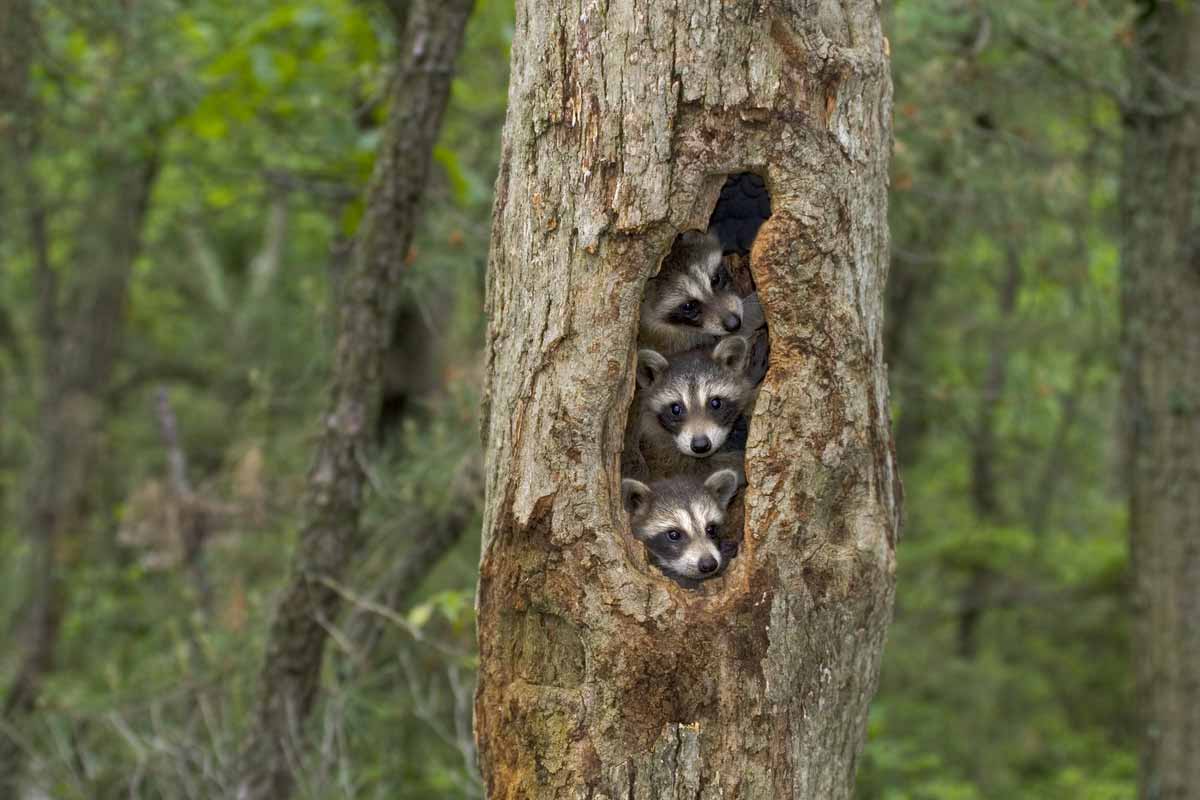
If the do-it-yourself options don’t work or you aren’t interested in doing it yourself, it may be time to call a wildlife removal company. Specialists can install one-way doors, which will allow the raccoons to leave but they won’t be able to get back in. Depending on how many raccoons you have, it can take a few days for them all to get out. Once the raccoons are out, you can repair the areas where they were able to get in, to keep them from getting back in.
Wildlife removal companies are also trained to trap animals humanely and relocate them in the best possible locations for their survival. It’s always a good idea to call a professional or a specialist to help with a problem that may seem too dangerous to fix yourself.
Sources:
http://www.pbs.org/wnet/nature/raccoon-nation-raccoon-fact-sheet/7553/
https://www.livescience.com/52655-raccoons.html
http://www.dem.ri.gov/programs/bnatres/agricult/pdf/raccoons.pdf
https://www.cdc.gov/parasites/baylisascaris/gen_info/faqs.html
https://www.cdc.gov/parasites/giardia/general-info.html
https://wdfw.wa.gov/living/raccoons.html
http://www.ladybug.uconn.edu/FactSheets/raccoons.php#
https://www.psu.edu/dept/nkbiology/naturetrail/speciespages/raccoon.htm
http://www.allwildlife.ca/blog/how-to-tell-if-raccoons-are-in-the-attic-what-steps-to-take
http://www.humanesociety.org/animals/resources/tips/scrap_the_trap.html
http://www.humanesociety.org/animals/raccoons/tips/raccoon_health_concerns.html
http://www.animalatticpest.com/equipment.html
https://pestkill.org/other/raccoons/repellents-and-deterrents/
http://ontariospca.ca/raccoon-fact-sheet.html
http://www.humanesociety.org/animals/raccoons/tips/raccoon_health_concerns.html
http://www.humanesociety.org/animals/raccoons/tips/raccoons_attic_chimney.html
https://www.mspca.org/animal_protection/about-raccoons/
Treating Your Property For Raccoons
Raccoon Problem?
Sources
https://www.terminix.com/pest-control/raccoons/raccoon-feces/
http://www.wildlife-removal.com/raccoonpoop.html
https://www.skedaddlewildlife.com/what-do-raccoons-sound-like/
https://www.bear-tracker.com/coon.html
Raccoon Sounds
Extremely vocal animals, raccoons communicate using more than 200 different sounds, which include chittering, purring, growling, snarling, hissing, and whimpering. Fighting raccoons sound like that of fighting cats, and they can scream with an owl-like screech. Baby raccoon will even mewl, cry, and whine.
Raccoon Tracks
Raccoons have five toes on both front and hind feet, with long, nimble fingers for grasping and getting into things. Their hind feet (and legs) are much larger than the front and their prints are often compared to that of human baby hand- and footprints.
Raccoon Poop
Raccoon poop is very similar to dog droppings but with the telltale sign of undigested food, the biggest tell being the addition of berries. Their poop is usually two to three inches long, three-quarters of an inch in diameter, with rounded or broken off tips, and textured sides.




